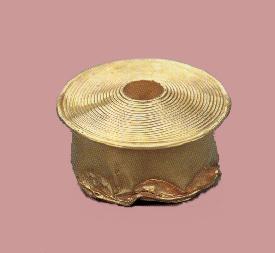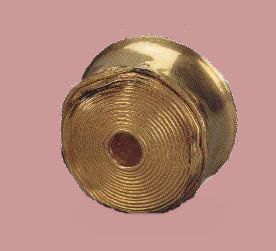

|
Gold
Height 3.2 cm.
diameter 5.6 and 3 cm.
weight 31.2 and 51.9 gr.
Usak Museum
The two spool-shaped rattles are virtually identical. Each is formed from two disk-shaped end pieces) a side sheet with concave profile and a central cvlindrical tube which is turned over at the ends to secure the disks. One has seventeen concentric rings on the die-formed faces) the other fifteen. The crumpled edges of the rattles are the result of an attempt by the grave robber to open them and identit the cause of the rattling sound. The difference in weight between the two rattles is due to the removal of the contents of one of them.
Such rattles were perhaps attached in pairs to a rod and used as a kind of sistrum. Very similar is a gold "rattle (or possibly reel)" from Sardis, Tomb 213 (5.3 cm. in diameter and 3.2 cm. high) with nineteen concentric circles of wire on one end) and containing twenty-seven pellets (average diameter 2.2 mm., combined weight 2.4 gr). The tomb yielded seventeen other items - two bronze mirrors) a silver omphalos phiale and silver bowl, a chalcedony seal in a gold mount, two gold rings, necklace of gold and carnelian, pottery "ampulla", terra-cotta open lamp, and seven stone alabastra. von Bothmer cites four other pairs - in Izmir, from Iasos; in Paris, collection de Clercq, from Cyprus; and two from lalysos, Rhodes. The method of construction is virtually identical to that used for a pair of gold ear reels in the British Museum (CR 1872.6-4.845-6), of the late 5th century BC, which also have concentric rings on the dieformed faces. The earrings from the Tomb of the Carian Princess at Halicarnassos are structurally dissimilar, but have the same concentric rings on their faces.
|
|









